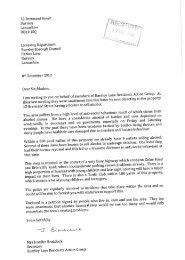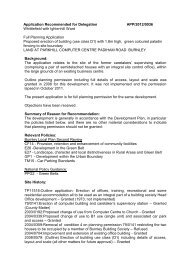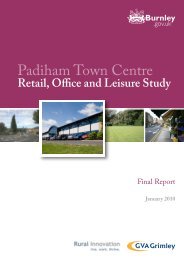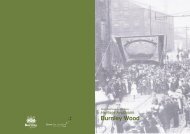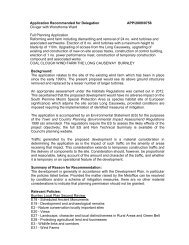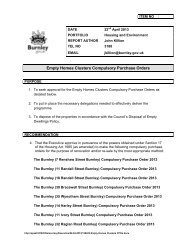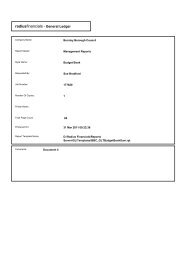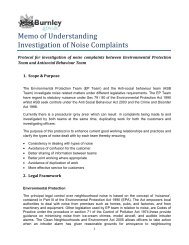The Padiham Heritage Appraisal - Burnley Borough Council
The Padiham Heritage Appraisal - Burnley Borough Council
The Padiham Heritage Appraisal - Burnley Borough Council
- No tags were found...
You also want an ePaper? Increase the reach of your titles
YUMPU automatically turns print PDFs into web optimized ePapers that Google loves.
Early residential area 1860-18906.3.8 <strong>The</strong> next properties to be built in the character area were eleven dwellings on VictoriaTerrace (now shops at 133-153 <strong>Burnley</strong> Road), a group of eight adjacent properties thenknown as Veevers Houses (2-10 Veevers Street and 155-159 <strong>Burnley</strong> Road), and on theother side of <strong>Burnley</strong> Road, James Street and the beginnings of Hapton Street (1861Census).<strong>The</strong> properties on Victoria Terrace would originally have had front gardens prior to wideningof <strong>Burnley</strong> Road in 1903 (Plans C & D). Census records of 1861 and 1871 show these earlyproperties to be predominantly inhabited by higher ranking textile workers/managers and otherskilled tradesmen/businessmen. One of these was William Foster who founded the adjacentSpa mule spinning Mill on the south bank of the Calder in 1860/61 and lived at that time at3 Veevers Houses. <strong>The</strong> close mix of industry and housing in this early settlement was furtheremphasised in 1867 when Spa or Victoria Foundry was established at the rear of VictoriaTerrace by Francis Helm, continuing there until 1894 when it relocated within the Spa Mill site(Plan C). Spa Mill and Spa Street (originally known as Victoria Street) take their name fromthe nearby well which was the most significant on that side of the river. Much of the Spa Millsite including the base of the chimney was cleared in 1992/3 and the demolition of remainingbuildings (weaving shed) was carried out in 2005. Development of the site for housing iscurrently underway.6.3.9 Number 1 Victoria Street (Spa Street) and Veevers Houses (155-159 <strong>Burnley</strong> Roadand 2-10 Veevers Street) are properties of significant character built of ashlared sandstonewhose characteristic orangey hue is still evident away from the polluting effects of main road.1 Victoria Street was occupied in 1861 by John Smith who was appointed <strong>Padiham</strong>’s AssistantOverseer (poor rate collector) in 1855 and Inspector of Nuisances in 1857. 153-159 <strong>Burnley</strong>Road have a prominent position close to a recognised gateway into <strong>Padiham</strong> (see 6.3.20). Likethose on the adjacent Victoria Terrace, the properties originally had front gardens. <strong>The</strong>y retainoriginal ornate door surrounds but the quality of the stonework and detailing generally haseroded over time.6.3.10 Veevers Houses may have been developed by Ambrose Veevers, a mechanic whowas resident in Victoria Terrace in 1868 (Mannex 1868) but there are no building recordsto confirm this. Numbers 2-10 (pre 1861) have a distinctive small and narrow plan withlow sunken doorways. <strong>The</strong> street has retained its traditional stone setts and a cast ironstreetlighting column (Plan F). Today’s Veevers Street is hidden away behind the <strong>Burnley</strong> Roadproperties. However, a new housing development on the former Spa Mills site will includepedestrian access via Spa Street and this may increase the usage and profile of these earlystreets.6.3.11 <strong>The</strong>se houses on <strong>Burnley</strong> Road (153-159) and those on Veevers Street (2-10) andSpa Street have been identified as Buildings of Local <strong>Heritage</strong> Value and recommended for<strong>Heritage</strong> Enhancement (Plan F).6.3.12 Off <strong>Burnley</strong> Road, the construction (by 1861) of James Street (37 houses) and 2houses on Hapton Street marked the development of the gridiron network of streets whichcharacterises much of the area (Plan C). By 1871 James Street (front and back) had 55houses, Hapton Street had 12 and Altham Street had 24 houses. However, by the time theLocal Board was formed in 1873, James Street was the only paved street in the town and<strong>Padiham</strong> exhibited many of the problems associated with rapid expansion. <strong>The</strong>re was no wayof dealing with the sewage which went into the river by stone drains and the water was impure.(Haines and Jones 1994).6.3.13 Throughout the 1870s development continued steadily in the surrounding area withPendle Street, Wesley Street/Cross Bank, Bright Street, Pitt Street, Peel Street, HambledonStreet all under construction before 1878. Only the parallel running Peel Street and Pitt Streetdepart from the straight grid, their ‘dog legs’ providing visual interest, briefly heightening thesense of enclosure before the streets straighten out and open views are restored.58 heritage appraisal



